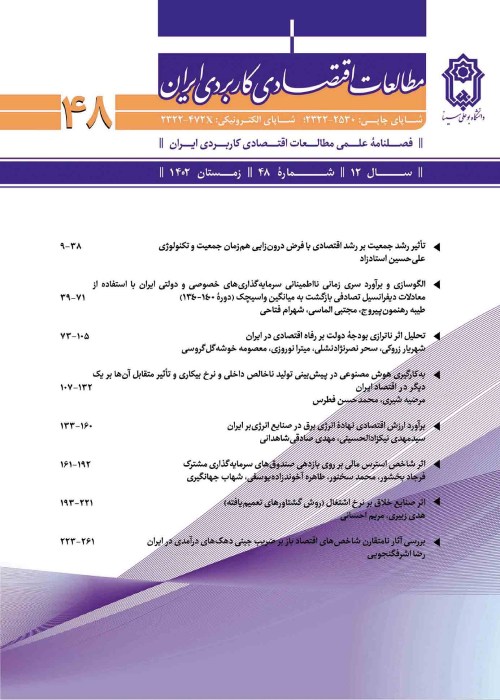Sensitivity of economic growth to life and non-life insurances
Author(s):
Abstract:
Economic growth has always been one of the core objectives of economic system, and this growth is not possible without funding. Insurance companies are financial institutions that beside the effective development and by providing capital economic security can create funds during the intervals of receiving premium or paying damages in order to provide the context for economic growth by accumulation of capital.
In a classification, insurance market activities are divided into two parts of life insurance and non-life insurance. Life insurance is the fund of risks that threaten humans health, life, and ability of working. Therefore, the risks that are mainly covered in individuals insurance are incident, illness, permanent disability, retirement, old age, and death. Non-life insurance includes in fact all insurance subjects except life insurances. This collection includes accident insurance, health insurance, fire insurance, cargo insurance, vehicle insurance (third-party and surplus insurance, drivers accident insurance and car body insurance), ship insurance, aircraft insurance, liability insurance, engineering insurance, oil and energy insurance, money insurance, credit insurance and other insurance types.
Therefore, the goal of this research is to investigate the impact of insurance on economic growth of 50 countries. In this study, two samples including 30 selected developed countries and 24 selected developing countries are studied. Various criteria such as countries diversity of geographic location and the availability of data have been used in the selection of countries. All data on the penetration rate of insurance have been extracted from the Sigma Journal and other information are extracted from the World Bank database. The distinction between this research and previous studies is in existence of the variables of this research (life and non-life insurance, physical capital accumulation, human capital, economic freedom, and accumulation of research and development costs) in the form of production function in the newer time period and more statistical society, and the use of dynamic panel statistical method. The endogenous growth model has been used to test the effect of insurance on economic growth.
The applied model is a dynamic panel model which is estimated through the two-step generalized method of moments (GMM) for panel data in the interval 2000-2015 using Eviews and Stata software. This method is more suitable than other methods for at least three reasons. Endogenous variables can be used in this method. One of the advantages of this method is that it allows to use the interruption of these variables as appropriate tools for controlling the endogeneity. The second advantage of this method is that one can insert the dynamics of the variable under consideration in the model, and the third advantage is that this method can be used in all time-series, cross-sectional and panel data. To do this research, four regression models were considered to determine the impact of life insurance on the economic growth of developed countries, to determine the impact of non-life insurance on the economic growth of developed countries, to determine the impact of life insurance on economic growth of developing countries, and to determine the impact of non-life insurance on economic growth of developing countries. The results of the four estimates suggest that life and non-life insurance have a positive and significant effect on the economic growth of developing and developed countries. In developing countries, the impact of non-life insurance on economic growth is greater than life insurance, while in developed countries, life insurance has a greater role. The effect of life and non-life insurance on the growth of developing countries is higher than developed countries. Therefore, due to the low level of per-capita income and GDP in developing countries, the impact of life and non-life insurance on their economic growth is higher than that of developed countries. There is a long-term relationship between life and non-life insurance in the two groups of selected countries. Also, other results showed the positive significant impact of the accumulation of physical capital, human capital, accumulation of research and development costs, and trade openness on economic development of the both groups of selected countries.
In a classification, insurance market activities are divided into two parts of life insurance and non-life insurance. Life insurance is the fund of risks that threaten humans health, life, and ability of working. Therefore, the risks that are mainly covered in individuals insurance are incident, illness, permanent disability, retirement, old age, and death. Non-life insurance includes in fact all insurance subjects except life insurances. This collection includes accident insurance, health insurance, fire insurance, cargo insurance, vehicle insurance (third-party and surplus insurance, drivers accident insurance and car body insurance), ship insurance, aircraft insurance, liability insurance, engineering insurance, oil and energy insurance, money insurance, credit insurance and other insurance types.
Therefore, the goal of this research is to investigate the impact of insurance on economic growth of 50 countries. In this study, two samples including 30 selected developed countries and 24 selected developing countries are studied. Various criteria such as countries diversity of geographic location and the availability of data have been used in the selection of countries. All data on the penetration rate of insurance have been extracted from the Sigma Journal and other information are extracted from the World Bank database. The distinction between this research and previous studies is in existence of the variables of this research (life and non-life insurance, physical capital accumulation, human capital, economic freedom, and accumulation of research and development costs) in the form of production function in the newer time period and more statistical society, and the use of dynamic panel statistical method. The endogenous growth model has been used to test the effect of insurance on economic growth.
The applied model is a dynamic panel model which is estimated through the two-step generalized method of moments (GMM) for panel data in the interval 2000-2015 using Eviews and Stata software. This method is more suitable than other methods for at least three reasons. Endogenous variables can be used in this method. One of the advantages of this method is that it allows to use the interruption of these variables as appropriate tools for controlling the endogeneity. The second advantage of this method is that one can insert the dynamics of the variable under consideration in the model, and the third advantage is that this method can be used in all time-series, cross-sectional and panel data. To do this research, four regression models were considered to determine the impact of life insurance on the economic growth of developed countries, to determine the impact of non-life insurance on the economic growth of developed countries, to determine the impact of life insurance on economic growth of developing countries, and to determine the impact of non-life insurance on economic growth of developing countries. The results of the four estimates suggest that life and non-life insurance have a positive and significant effect on the economic growth of developing and developed countries. In developing countries, the impact of non-life insurance on economic growth is greater than life insurance, while in developed countries, life insurance has a greater role. The effect of life and non-life insurance on the growth of developing countries is higher than developed countries. Therefore, due to the low level of per-capita income and GDP in developing countries, the impact of life and non-life insurance on their economic growth is higher than that of developed countries. There is a long-term relationship between life and non-life insurance in the two groups of selected countries. Also, other results showed the positive significant impact of the accumulation of physical capital, human capital, accumulation of research and development costs, and trade openness on economic development of the both groups of selected countries.
Language:
Persian
Published:
Quarterly Journal of Applied Economics Studiesin Iran, Volume:6 Issue: 23, 2017
Pages:
207 to 230
magiran.com/p1756167
دانلود و مطالعه متن این مقاله با یکی از روشهای زیر امکان پذیر است:
اشتراک شخصی
با عضویت و پرداخت آنلاین حق اشتراک یکساله به مبلغ 1,390,000ريال میتوانید 70 عنوان مطلب دانلود کنید!
اشتراک سازمانی
به کتابخانه دانشگاه یا محل کار خود پیشنهاد کنید تا اشتراک سازمانی این پایگاه را برای دسترسی نامحدود همه کاربران به متن مطالب تهیه نمایند!
توجه!
- حق عضویت دریافتی صرف حمایت از نشریات عضو و نگهداری، تکمیل و توسعه مگیران میشود.
- پرداخت حق اشتراک و دانلود مقالات اجازه بازنشر آن در سایر رسانههای چاپی و دیجیتال را به کاربر نمیدهد.
In order to view content subscription is required
Personal subscription
Subscribe magiran.com for 70 € euros via PayPal and download 70 articles during a year.
Organization subscription
Please contact us to subscribe your university or library for unlimited access!



